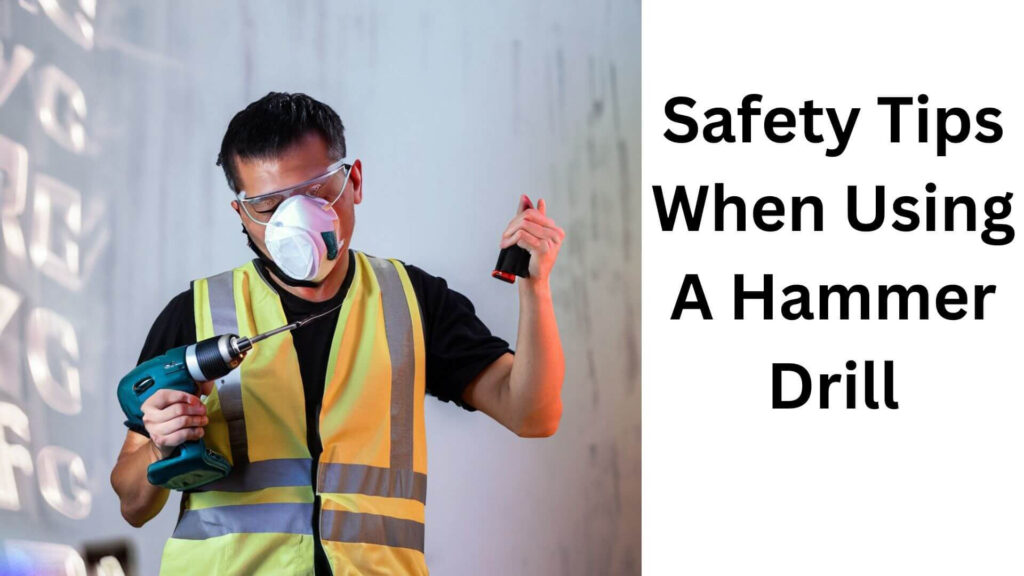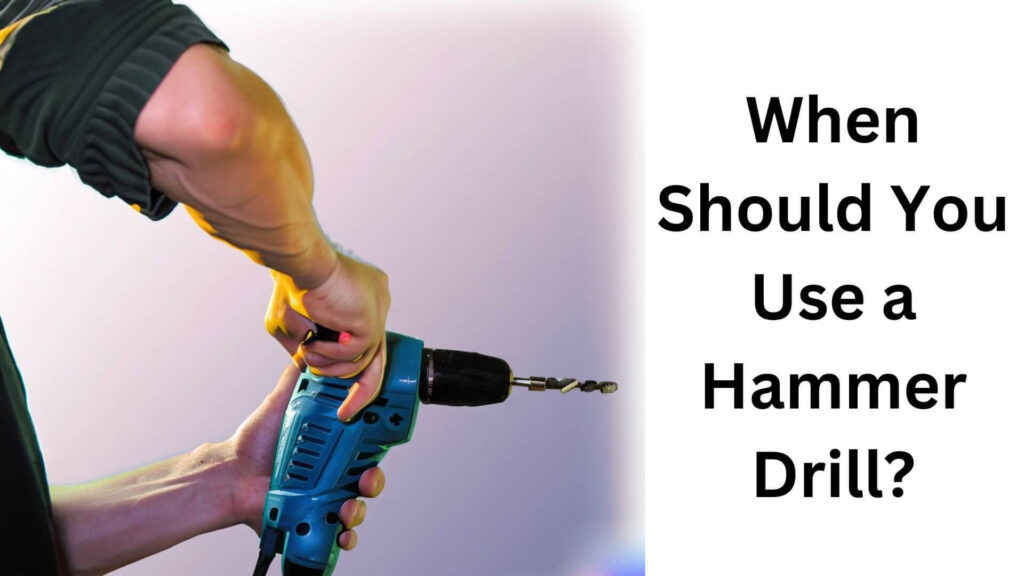When tackling construction or DIY projects, the right tool can make all the difference. One tool that stands out for its versatility in drilling through tough materials is the hammer drill. Whether you’re working with concrete, brick, stone, or masonry, a hammer drill can significantly ease the task.
But when should you use a hammer drill? In this post, I’ll explore the optimal scenarios for using a hammer drill, offer usage tips, and discuss the benefits it provides in various applications.
Table of Contents
Advantages Of Using A Hammer Drill
Hammer drills are specifically designed for more demanding drilling tasks. They combine rotational action with a hammering motion, allowing you to break through hard materials more efficiently than a regular drill.
1. Efficiency in Tough Materials
Hammer drills are ideal for drilling into hard surfaces like concrete, stone, masonry, and brick. The hammering action breaks down the tough material while the bit rotates to clear away the debris. This combination makes the task faster and more efficient than using a standard drill.
2. Time-Saving
Due to its ability to penetrate hard materials quickly, a hammer drill can save significant time on construction or renovation projects. What might take several minutes or even hours with a regular drill can be accomplished in a fraction of the time using a hammer drill.
3. Increased Precision
With a hammer drill, you have better control over the drilling process, which results in cleaner and more precise holes. This is particularly important for professional contractors who need to maintain accuracy when drilling into walls or flooring for installations.
4. Durability
Hammer drills are built to handle heavy-duty jobs and can withstand high-impact forces that would wear out a regular drill. This makes them highly durable, especially when working on large-scale or prolonged projects.
Read More: Can a Hammer Drill Be Used As a Chisel?
Factors To Consider When Deciding To Use A Hammer Drill
Not every drilling task requires a hammer drill. Several factors should be considered when deciding whether to use one:
1. Material Type
The primary factor that determines whether you should use a hammer drill is the type of material you’re working with. Hammer drills are optimized for hard materials, such as:
- Concrete
- Brick
- Stone
- Masonry
For softer materials like wood, plastic, or drywall, a regular drill will suffice, and using a hammer drill could even cause unnecessary damage.
2. Hole Depth and Diameter
If you’re drilling large or deep holes into hard materials, a hammer drill will perform better than a regular drill. When working with a standard drill, you might encounter resistance as the bit dulls or overheats, especially for holes larger than ½ inch in diameter or more than a few inches deep.
3. Power Requirements
Hammer drills typically require more power than regular drills. If you’re working on a high-power task where extra torque is needed, such as installing anchors or bolts into concrete, a hammer drill is a better choice. This is particularly true when using larger bits or drilling through reinforced concrete, where extra impact force is necessary.
4. Frequency of Use
If you’re only occasionally drilling into hard materials, it might not make sense to invest in a hammer drill. However, if you frequently encounter tough materials in your projects, a hammer drill is a worthy investment.
5. Project Scope
For large construction projects or renovation tasks where multiple holes need to be drilled into tough materials, a hammer drill will be much more efficient. Smaller tasks involving softer materials might not justify the need for one.
Read More: Can a Hammer Drill Be Used As a Regular Drill?
When Should You Use A Hammer Drill?
Now that we’ve established the key factors to consider, let’s look at the specific scenarios where using a hammer drill is essential:
1. Drilling Into Concrete
Concrete is a common material in construction, but it’s also one of the toughest to work with. A hammer drill is specifically designed to penetrate concrete efficiently, making it the tool of choice for jobs like installing anchors, bolts, or electrical boxes. Standard drills struggle with concrete, often resulting in slower progress and overheated bits.
2. Working With Masonry
Masonry includes materials like bricks, cinder blocks, and stone. When you need to install shelves, cabinets, or lighting fixtures into a brick wall, a hammer drill is your best bet. The hammering action helps break apart the dense material, allowing for easier drilling.
3. Installing Fixtures Into Stone
Natural stone, like granite and marble, is often used in countertops and flooring. If you’re drilling holes for mounting brackets, faucets, or electrical outlets, a hammer drill is the only effective tool for the job. Regular drills will not generate enough impact force to break through these hard surfaces.
4. Concrete Flooring Installations
Hammer drills are ideal for installing anchors or bolts in concrete flooring. Whether you’re installing heavy equipment, building a deck, or anchoring furniture, a hammer drill ensures you can penetrate the thick concrete surface without damaging your drill or bit.
5. Creating Holes For Pipes Or Electrical Wiring
In many construction and renovation tasks, you may need to drill through concrete or brick to run plumbing pipes or electrical wiring. A hammer drill makes this task faster and safer, allowing for precise hole drilling without cracking the surrounding material.
6. Drilling Pilot Holes For Fasteners
When working with masonry or stone, creating pilot holes with a hammer drill is essential for inserting fasteners. Pilot holes guide the screw or anchor into the material, making installation more secure and reducing the chance of material cracking.
Safety Tips When Using A Hammer Drill
Safety should always be a priority when operating power tools, especially when using a hammer drill, which involves high power and heavy impact.

1. Wear Proper Safety Gear
- Eye Protection: Drilling into hard materials can cause chips and debris to fly into the air, making safety goggles essential.
- Ear Protection: Hammer drills can be loud, especially when drilling into concrete, so wearing earplugs or noise-canceling headphones is a good idea.
- Gloves: Wear sturdy gloves to protect your hands from vibration and dust.
2. Secure The Work Surface
Ensure the material you’re working on is stable and secured. For walls, make sure there’s no risk of the material collapsing. For floors or panels, use clamps to keep them in place.
3. Use The Correct Bit
Always select the appropriate hammer drill bit for the material you’re drilling into. Using the wrong bit can lead to inefficient drilling and damage to both the drill and the material.
4. Check for Hidden Utilities
Before drilling, ensure there are no pipes, wires, or conduits in the area you’re working on. Hitting a hidden water pipe or electrical wiring can be dangerous.
5. Hold The Drill Steadily
Maintain a firm grip on the drill with both hands. Hammer drills produce strong vibrations, and failing to hold them securely can lead to loss of control and potential injury.
6. Drill At a Consistent Speed
Avoid applying too much pressure or using an erratic speed when drilling. Keep the drill steady and use a slow, consistent speed for the best results.
Frequently Asked Questions For When Should You Use A Hammer Drill
1. Can I Use A Regular Drill Instead Of A Hammer Drill For Concrete?
While it is possible to use a regular drill for light drilling in concrete, it is highly inefficient and can damage the drill. A hammer drill is specifically designed to handle the percussive action needed to penetrate hard materials like concrete.
2. What Is The Difference Between A Hammer Drill And A Rotary Hammer?
A hammer drill combines rotational drilling with a hammering action, while a rotary hammer is a more powerful tool that uses a piston mechanism to deliver more forceful hammer blows. Rotary hammers are typically used for heavy-duty construction work and larger holes.
3. What Kind Of Bit Should I Use In A Hammer Drill?
Use masonry bits or carbide-tipped bits when drilling into concrete, brick, or stone. These bits are designed to withstand the hammering action and can penetrate tough materials more effectively.
4. Can I Use A Hammer Drill For Wood?
A hammer drill can technically be used on wood, but it’s not recommended. The hammering action could cause unnecessary damage, splitting the wood or leaving rough holes. Use a regular drill for wood or softer materials.
5. Do I Need Special Safety Gear For A Hammer Drill?
Yes, using safety goggles, ear protection, and gloves is essential when using a hammer drill, as the tool generates dust, debris, and loud noise.
Final Opinion
A hammer drill is a valuable tool for anyone working with hard materials like concrete, stone, and masonry. Knowing when and how to use a hammer drill can save you time, effort, and frustration, especially for construction and renovation projects that require precise drilling.
By understanding the benefits of using a hammer drill, evaluating the factors for each project, and following safety protocols, you can maximize the effectiveness of this powerful tool. Whether you’re installing anchors into concrete walls or running wiring through stone, a hammer drill ensures a clean and efficient result.
Ultimately, investing in a hammer drill is a smart choice for frequent DIYers, contractors, or anyone who regularly encounters hard materials in their work. By following optimal usage tips and scenarios, you’ll be better equipped to tackle even the toughest drilling jobs.

Hey, I am MD Hrithik Hossain, I’m a huge fan of DIY crafts. My workshop is where I spend most of my spare time, and I’m always working on some project. To that end, I’d like to share some of my knowledge and experience with you in power tools, woodworking, and other specialized materials fabrication.
I will guide you with genuine knowledge that can assist you with deciding whether a drill is appropriate according to your requirements or not. If you want to find the best drill and know which type of drill is most suited for your needs, then I can guide you with my expertise. My passion lies in helping others find the correct products they need at an affordable price.


